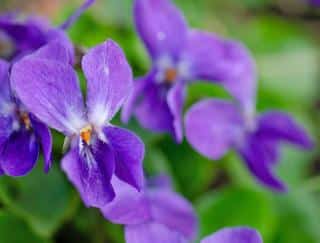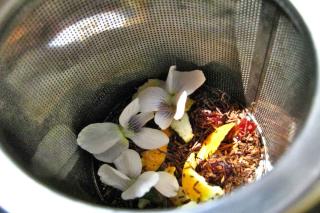Violet (Viola odorata) is a small bushy plant with violet or white flowers, native to Asia, Europe, and North Africa. It is part of the Violaceae family.
It is known for its medicinal properties and the many health benefits it procures the body.
Health benefits of violet
- Expectorant properties make violet an ideal treatment in case of respiratory infection (colds or bronchitis). An infusion prepared from 1 ½ oz (50 g) violet flowers for 1 quart (1 liter) boiling water soothes irritation and cough.
- Laxative and diuretic violet also treats light constipation, even for children.
 Since it is a light diaphoretic, violet is recommended in case of bouts of fever and flu symptoms.
Since it is a light diaphoretic, violet is recommended in case of bouts of fever and flu symptoms.- Soothing violet calms restlessness when inhaled, and it lowers stress and insomnia.
- Violet is also effective in case of indigestion or food poisoning.
- Topical use of violet leaves and roots, pulped and used in the form of hot poultices is effective against small wounds, crevasses on breasts subsequent to difficult breastfeeding, and bedsores.
Growing violet for its health benefits
- Your violet will do just great in part sun, preferably in rich, humus-rich, cool and well drained soil.
- Hardy and easy to care for, violet isn’t afraid when the thermometer level drops.
- You can grow it in pots without any problem, even in small garden boxes, because it has very short roots.
- Take note that in some countries, like France, many violet species are protected, so best harvest only those that grow in gardens.
Cooking violet for its health benefits
- Young violet leaves can be eaten raw or cooked, in mixed salads. Cooking them can be done for instance to thicken soup or broth, because they are mucilaginous (they thicken in water).
 Tea is of course a favorite. Pair it with other more tasty herbs like carcade. Will give your tea a thick, creamy feel.
Tea is of course a favorite. Pair it with other more tasty herbs like carcade. Will give your tea a thick, creamy feel.- Violet flowers decorate salads and are often candied with sugar to produce a famous sweet, originally called Violette de Toulouse. Their flavor really stands out in cakes, syrups, honey and vinegar, and you can also make jam and jelly from them.
Image credits (edits Gaspard Lorthiois):
CC BY 2.0: LL Barkat
Pixabay: Hans Braxmeier, Katharina N.


 Since it is a light diaphoretic, violet is recommended in case of bouts of fever and flu symptoms.
Since it is a light diaphoretic, violet is recommended in case of bouts of fever and flu symptoms. Tea is of course a favorite. Pair it with other more tasty herbs like carcade. Will give your tea a thick, creamy feel.
Tea is of course a favorite. Pair it with other more tasty herbs like carcade. Will give your tea a thick, creamy feel.